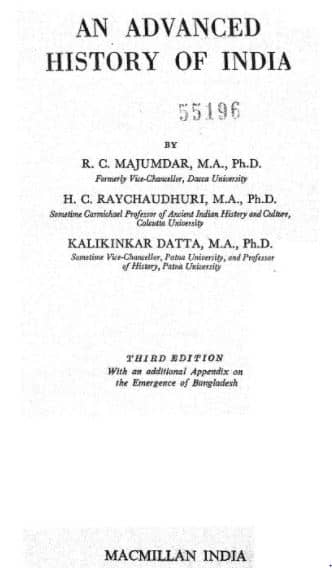‘Advanced History Of India’ PDF Quick download link is given at the bottom of this article. You can see the PDF demo, size of the PDF, page numbers, and direct download Free PDF of ‘An Advanced History Of India RC Majumdar’ using the download button.
An Advanced History Of India Book PDF Free Download

An Advanced History Of India
PHYSICAL ASPECTS AND UNDERLYING UNITY
INDIA is the name given to the vast peninsula that the continent of Asia throws out to the south of the magnificent mountain ranges that stretch in a swordlike curve across the southern border of Tibet.
This huge expanse of territory, which deserves the name of a sub-continent, has the shape of an irregular quadrilateral.
Ancient geographers referred to it as being constituted with a four-fold conformation on its south and west and east in the Great Ocean.
The Himavat range stretches along its north like the string of a bow”. The lofty mountain chain in the north to which the name.
Himavat applied in the above passage includes not only the snow-capped ridges of the Himalayas but also their loss of elevated offshoots of the Patkai.
Luahai and Chittagong Hills in the east, and the Sulaiman and Kirthar ranges in the west. These lead down to the sea and separate the country from the wooded valley of the Irrawaddy.
On the one hand and the hilly tableland of Iran on the other. Politically, the Indian empire as it existed before August 15, 1947.
Extended beyond these natural boundaries at several points and included not only Baluchistan beyond the Kirthar range but also some smaller areas that lay scattered in the Bay of Bengal.
With the exception of the outlying territories beyond the seas, the whole of the vast region described above lay roughly between Long. 61° and 97 E. and Lat. 8° and 37 N.
Its greatest length was about 2,900 kilometers, and its breadth was not less than 2,190 kilometers. The total area of the empire, excluding.
Burma which was constituted as a separate unit under the Government of Indis Act of 1935, might be put at 4,095,000 square kilometers and the population inhabiting it.
According to the census of 1941, the last taken before the creation of Pakistan, at about three hundred and eighty-nine million.
The sub-continent of India, stretching from the Himalayas to the sea, is known to the Hindus as Bhdrafa-Varsha or the land of Bharata, a king famous in Puraidc tradition.
It was said to form part of a larger time called Jambu-dmpa which, was considered to be tbe time most of the seven concentric island continents int( which the earth, as conceived by Hindu cosmographers, was supposed to have been divided.
The i^rapic account of this insular continent contains a good deal of what is fanciful, but early Buddhist evidence suggests that Jainbu-dvipa was a territorial designation actually in use from the third century B.o. at the latest, and was applied to that part of Asia, outside China, throughout which the prowess of the great imperial family of the Mauryas made itself felt. The name “India” was applied to the country by the Greeks.
It corresponds to the “Hi(n)du” of the old Persian epigraphs. Like *8apta aindhavah^ and ‘‘Hapta Hindu^* — ^the appellations of the country of the Aryans in the Veda and the Vendidad — ^it is derived from the Sindhu (the Indus), the great river which constitutes the most imposing feature of that part of the sub-continent which seems to have been the cradle of its earliest known civilization. Closely connected with ‘”Hindu*’ are the later designations “Hind” and Hindusthdn” as found in the pages of medieval writers.
The course of Indian history, like that of other countries in the world, is in large measure determined by its geography.
Each of the territorial units into which the hand of nature divides the country has a distinct story of its own.
The intersection of the land by deep rivers and winding chains flanked by sandy deserts or impenetrable forests fostered a spirit of isolation and cleft I country asunder into small political and even social units, whose I divergences were accentuated by the infinite- variety of local p conditions.
Tendencies towards union and coalescence are most marked only in the vast riparian plain of the north and the? the extensive plateau in the interior of the peninsula, enriched and regenerated by the life-giving streams that flow from the heights of the Himalayas and the Western Ghats.
The stupendous mountain chain which fences this country off from the rest of Asia, while it constituted India a world by itself and favored the growth ^ of a distinct type of civilization, never sufficed to shelter the sunny realms of the Indus and the Ganges from the inroads of ambitious potentates or wandering nomads.
These invaders stormed one after another through the narrow defiles that break through the great rocky barrier and lead into the plains of the interior.
The long coast studded with wealthy ports “lay open to the barks of” intrepid buccaneers and adventurers from far-off climes.
Ancient India book of R C Majumdar
| Author | R.C.Majumdar H C Raychaudhary |
| Language | English |
| Pages | 1149 |
| PDF Size | 395 MB |
| Category | History |
Related PDFs
Ancient Indian History PDF In Hindi
An Advanced History Of India PDF
An Advanced History Of India Book RC Majumdar PDF Free Download

I had a quick question on the licensing rights of the pdf. Seems that their licensing has expired and they are freely available. I have started a digital library in USA and just wanted to know if I can have these titles in my digital library.
Yes, you can continue with the title. But it is hard to find License is expired or not. So, be ready for DMCA. Goodluck.